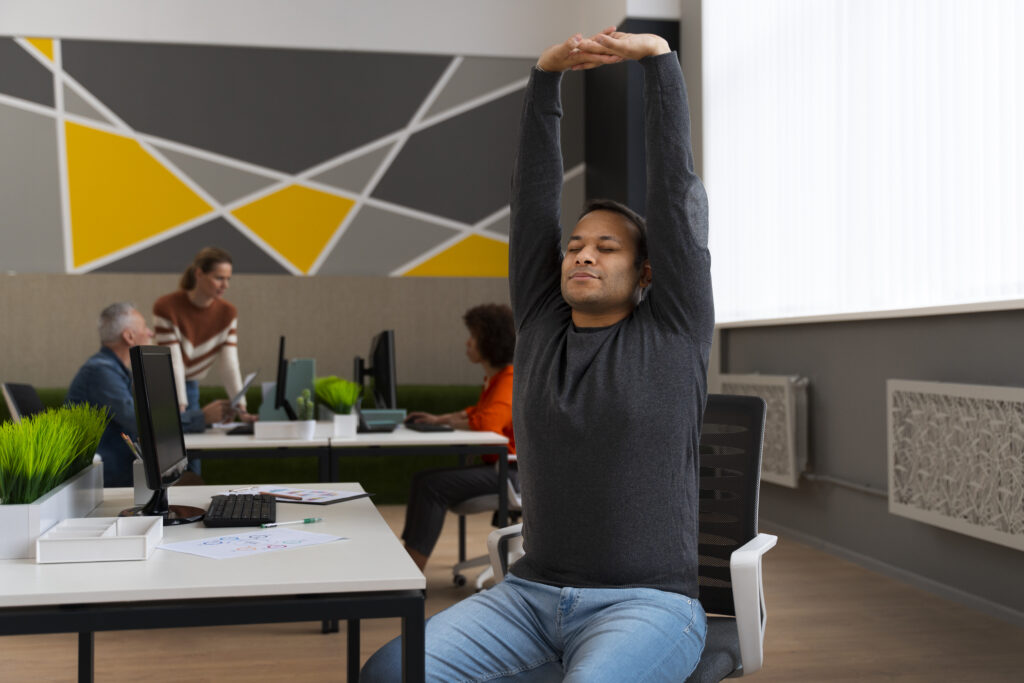In today’s fast-paced work environment, prioritizing mental health is no longer a luxury, it’s a necessity. Employees face constant pressure to meet deadlines, manage workloads, and navigate complex professional dynamics. This relentless focus can lead to burnout, decreased productivity, and a decline in overall well-being. The solution? Championing mental health breaks at work.
Why Mental Health Breaks Matter
Mental health breaks are more than just a chance to grab a coffee or scroll through social media. They’re a strategic investment in your workforce, offering a multitude of benefits for both individuals and organizations. Here’s a closer look at how these breaks can positively impact your workplace:
1. Reduced Stress and Anxiety:
Work can be a pressure cooker. Deadlines loom, workloads pile up, and interpersonal dynamics can add to the strain. This constant pressure manifests in a variety of ways, including:
Physical Symptoms: Headaches, fatigue, muscle tension, digestive issues
Emotional Symptoms: Irritability, anxiety, difficulty concentrating, feelings of overwhelm
Behavioral Symptoms: Procrastination, increased reliance on stimulants like caffeine, difficulty sleeping
Short mental health breaks offer a critical opportunity to de-stress. By stepping away for a few minutes, employees can:
Engage in relaxation techniques:
Deep breathing exercises, progressive muscle relaxation, or a short meditation session can calm the nervous system and reduce physical tension.
Practice mindfulness:
Taking a few moments to focus on the present moment can help employees detach from worries and anxieties, promoting a sense of calm and clarity.
Engage in activities they enjoy:
Listening to music, reading a few pages of a book, or spending a few minutes with a coworker can provide a welcome mental break and a mood boost.
By promoting mental health breaks, you’re equipping your employees with tools to manage stress effectively, leading to a healthier and happier workforce.
2. Enhanced Creativity and Problem-Solving:
Ever get stuck staring at a problem with no solution in sight? A mental health break can be the key to unlocking new perspectives. Here’s why:
Cognitive Disengagement: When you’re constantly focused on a task, your brain gets stuck in a narrow mental rut. Taking a break allows your brain to disengage from the problem, allowing for unconscious processing and the formation of new connections.
Increased Openness to Ideas: Stepping away from the problem can help you approach it with a fresh perspective. You might return with new ideas or see potential solutions you missed earlier.
Boosted Cognitive Flexibility: Mental breaks can enhance cognitive flexibility, the ability to shift your thinking, and consider different approaches. This is crucial for innovative problem-solving and creative thinking.
3. Increased Productivity:
Counterintuitively, taking breaks can lead to increased productivity. Here’s the science behind it:
Improved Attention Span: Constant focus leads to mental fatigue and decreased attention span. Short breaks help recharge your mental batteries, allowing you to return to your tasks with renewed focus and concentration.
Enhanced Decision-Making: When you’re mentally fatigued, decision-making suffers. Taking breaks helps you approach tasks with a clearer mind, leading to better decision-making and fewer errors.
Reduced Decision Fatigue: The more decisions you make throughout the day, the less willpower you have left for important choices. Mental breaks help you avoid decision fatigue, allowing you to make sound judgments when it matters most.
By promoting mental health breaks, you’re not encouraging laziness you’re enabling your employees to work smarter, not harder.
Advocating for Designated Break Spaces

Creating designated break spaces isn’t just about offering a place to grab a snack; it’s about sending a powerful message: your company prioritizes the well-being of its employees. Here’s a comprehensive approach to advocating for dedicated break areas:
1. Build a Compelling Case: Data is Your Ally
Don’t go into this blind. Arm yourself with data and research that demonstrates the positive impact of mental health breaks on employee well-being, productivity, and overall company performance.
Share statistics on the prevalence of stress and anxiety in the workplace, and how breaks can help mitigate these issues (https://www.ccohs.ca/healthyworkplaces/topics/mentalhealth.html).
Cite studies that showcase the link between breaks and increased productivity (e.g., the DeskTime study showing a 21% productivity increase with short breaks https://desktime.com/faq/how-to-use-desktime-as-an-employee).
Highlight research on the connection between employee well-being and reduced absenteeism (e.g., the Society for Human Resource Management report on the cost of absenteeism https://www.shrm.org/).
2. Think Beyond the Beanbag Chair: Flexible Solutions for Diverse Needs
Break spaces don’t have to be extravagant. The key is to create a designated area that fosters relaxation and rejuvenation. Here are some flexible solutions:
Quiet Zones: Identify a dedicated area for peaceful respite. This could be a small room with comfortable seating, soundproofing materials, and calming lighting. Stock it with books, board games, or mindfulness resources.
Nature Connection: Consider incorporating biophilic design elements, like potted plants or access to an outdoor patio. Studies show that connecting with nature can significantly reduce stress levels (https://www.terrapinbrightgreen.com/report/biophilic-design/).
Activity Corners: Dedicate a space for light physical activity, with yoga mats, resistance bands, or a small exercise ball. Movement breaks can be highly effective in reducing stress and boosting energy levels.
3. Reimagine Underutilized Spaces: Optimizing Existing Resources
Think creatively! Is there an unused conference room, a rarely visited storage area, or a part of the office with poor natural light? These spaces can be transformed into functional and inviting break areas.
Partner with the facilities department to explore renovation possibilities.
Consider cost-effective solutions like movable partitions, comfortable floor cushions, and strategic lighting to create a distinct break zone.
4. Empower Employees Through Co-Creation:
Who better understands employee needs than the employees themselves? Involve them in the design process:
Conduct surveys or hold focus groups to understand employee preferences for break space amenities and activities.
Organize design competitions or brainstorming sessions to get creative input on the space layout and design.
Empower employees to take ownership by allowing them to decorate the space or contribute suggestions for activities or resources.
Championing Break Practices
Creating designated break spaces is a crucial step, but it’s only half the battle. The real win lies in encouraging employees to take advantage of those breaks. Here’s how to champion healthy break practices and cultivate a culture of well-being in your workplace:
1. Lead by Example: Normalize Break-Taking
Actions speak louder than words. The most effective way to encourage breaks is to model the behavior yourself. Schedule breaks into your workday, step away from your desk, and openly discuss the benefits you experience. Talk about how breaks help you recharge, improve your focus, and enhance your creativity.
2. Integrate Breaks into Routines: Scheduling for Success
Breaks shouldn’t be an afterthought; they should be an integrated part of the workday. Here are some strategies to promote regular pauses:
Calendar Reminders: Set recurring calendar alerts to prompt yourself and your team to take breaks.
The Pomodoro Technique: Implement the Pomodoro Technique, a time management strategy that involves working in focused 25-minute intervals followed by short 5-minute breaks.
Break Challenges: Organize lighthearted “break challenges” to encourage employees to step away from their desks. Award prizes or recognition for achieving a set number of breaks per week.
3. Disrupt the Hustle Culture: Prioritize Work-Life Balance
The notion that long hours equal good work is a myth. It can lead to burnout and decreased productivity. Here’s how to challenge the “hustle culture”:
Open Communication: Discuss the importance of work-life balance with your team. Encourage employees to set boundaries and disconnect after work hours.
Flexible Work Arrangements: Offer flexible work options like remote work or compressed workweeks to help employees manage personal commitments.
Respect Boundaries: Lead by example and respect employee boundaries during off-work hours. Avoid sending emails or expecting immediate responses outside of designated working hours.
4. Spark Joy with Activities and Resources:
Make break spaces more inviting by providing a variety of activities and resources that cater to different preferences:
Mindfulness Corner: Equip a dedicated area with meditation resources like guided audio recordings or mindfulness apps.
Game Zone: Offer board games, puzzles, or video games (on a limited basis) to promote friendly competition and lighthearted interaction.
Reading Nook: Stock the break space with books, magazines, or even a subscription to a book delivery service.
Wellness Activities: Consider offering on-site yoga or meditation sessions during breaks, led by certified instructors.
Building a Culture of Well-being
Mental health breaks are just one facet of a comprehensive well-being program. Consider these additional strategies:
Employee Assistance Programs (EAPs): Offer confidential mental health services like counseling and hotlines to employees.
Flexible Work Arrangements: Provide options like remote work or flexible hours to allow employees to manage personal commitments and reduce stress.
Mental Health Awareness Initiatives: Organize workshops or seminars on stress management, mindfulness, and mental health resources.
Open Communication: Encourage open communication about mental health within the workplace and create a safe space for employees to discuss their well-being concerns.
Investing in Your People
Mental health breaks are not a sign of weakness; they’re a sign of a forward-thinking organization that recognizes the importance of its employees’ well-being. By prioritizing mental health and creating a supportive work environment, you invest in your greatest asset – your people.


